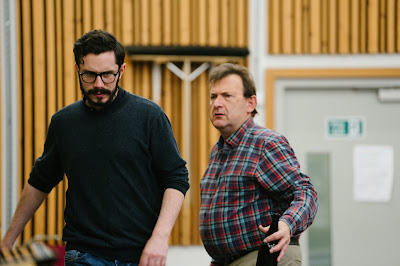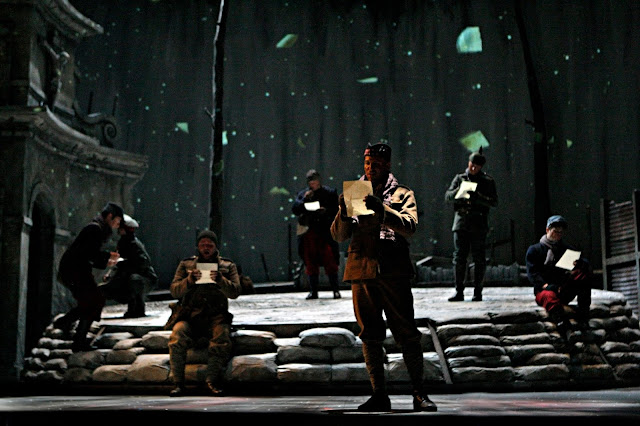 |
| Rehearsals for Opera North’s production of Kevin Puts' Silent Night, November 2018 Rupert Charlesworth as Nikolaus Sprink and Máire Flavin as Anna Sørensen - Photo Tom Arber |
 |
| Kevin Puts (Photo David White) |
A cinematic quality to the storytelling
The opera presents a number of challenges to those staging it, not just the depicition of war but the need to present three different fighting groups, the French, the Scots and the Germans. Kevin has seen five or six different productions of the opera, and each had a different solution. At Minnesota Opera, for the work's premiere, they used a turntable which contained the three bunkers (French, Scots and German).
The challenge comes because Mark Campbell's libretto moves very quickly, with quite short scenes, so that there is a cinematic quality to the storytelling and Kevin is not ashamed to admit that there is a cinematic quality to the music as well. So that many of the production of the opera have opted for realism in their depictions of the events.
 |
| Kevin Puts' Silent Night at Minnesota Opera in 2011 (Photography Michal Daniel) |
Silent Night begins with an opera on stage, and for the opera within the opera Kevin wanted to write in an 18th century style that was as authentic as he could, so that the audience felt they might be hearing Mozart. And from this, as the piece went along, he felt licensed to have stark juxtapositions of musical style from scene to scene. A theme does emerge, and this theme returns throughout the piece to give it an over-arching stylistic colour, a certain hue. Within this there are pastiche pieces, a Scottish ballad, Christmas carols, a 19th century operatic aria.
If he had not been asked to write Silent Night he is not sure when he would have moved into opera
 |
| Rehearsals for Opera North’s production of Kevin Puts Silent Night- Alex Banfield as Jonathan Dale and Adrian Clarke as Father Palmer Photo Tom Arber |
But once he started writing Silent Night he loved it, he loved the idea of storytelling in music, and only really realised this once he had started the opera. But, now he is in his 40s he is less passive and more deterministic in his career with his choice of work.
After Silent Night his next opera was also based on an existing film, The Manchurian Candidate (which was premiered in 2015 by Minnesota Opera), not so much because Kevin likes turning films into opera but because opera companies liked the idea. The Manchurian Candidate was something that people knew and it generated interest from the start. Opera companies are often afraid to do new work unless they feel that audiences have a route in to the piece, which the film connections seem to offer.
The opera after that was Elizabheeth Cree, a chamber piece based on a Peter Ackroyd novel. Whilst this was pre-existing, it was far less well known and the subject was in fact librettist Martin Campbell's suggestion. It appealed to Kevin because it was small scale, and because of the rather macbre subject, so it was an intriguing idea with plenty of situations for him to tackle. So far Kevin has not written an opera from scratch, but he finds it rather exciting to write something with no expectations.
When he was young he wanted to be a film producer
 |
| Rehearsals for Opera North’s production of Kevin Puts' Silent Night, Alex Banfield as Jonathan Dale with Director Tim Albery - Photo Tom Arber |
But at graduate school he studied composition and found that he had had enough of practising. Also, he loved the idea of not knowing what was going to come next in a piece. Something that he still finds exciting, the idea that a work might go anywhere. Writing music seemed to come easily to him, improvising at the piano, and he still usually works without a struggle.
The operas of Britten were a huge influence, the realistic nature of the writing for singers, the variety of harmonic worlds, the orchestration and the pace. Whilst he enjoys operas by contemporary figures such as John Adams and Thomas Ades, he is not specifically influenced by them though he is sure that it all filters in.
The need to create dialogue and yet it be singable and pleasurable
When writing his own operas he does not plant himself in front of a stack of scores of other works, he does not want to be close to anyone else's approach. He wants to be able to move from scene to scene in his own way. The challenge was to write for the voice, and he feels that his vocal writing has improved since Silent Night, the need to create dialogue and yet it be singable and pleasurable. It was this, rather than the orchestration, which was the challenge.
Silent Night had its own particular challenges too, it is written in five languages. And the German, especially, was tricky to do as Kevin had never studied the language. He normally writes by playing and singing at the piano, but this was not possible with the passages in German and he describes his method as 'painting by numbers', a very painstaking process matching harmonies, rhythms and text., something far more process orientated than he usually does.
 |
| Kevin Puts' Silent Night at Minnesota Opera in 2011 (Photography Michal Daniel) |
Kevin Puts' Silent Night - 30 November to 7 December 2018 at Leeds Town Hall - Opera North, director Tim Albery, conductor Nicholas Kok, with Maire Flavin, Rupert Charlesworth, Quirijn de Lang, Timothy Nelson, Richard Burkard, Geoffrey Dolton. Full details from Opera North website.
Kevin Puts on disc:
- Symphony No.2, Flute Concerto - Peabody Symphony Orchestra, Marin Alsop, Naxos - available from Amazon.
- Symphony No.4, To Touch The Sky, If I Were A Swan - Conspirare/Craig Hella Johnson, Baltimore Symphony Orchestra/Marin Alsop, Harmonia Mundi - available from Amazon.
Elsewhere on this blog:
- Puccini premiere: Opera Rara gives the original version of Le Willis a rare outing (★★★★) - Opera review
- Long time ago: Samling showcase at the Wigmore Hall (★★★★) - concert review
- A series of concentric circles: Aaron Holloway-Nahum and the Riot Ensemble - interview
- Auf Flügeln des Gesanges: Romantic songs and piano transcriptions from Christoph Prégardien & Cyprien Katsaris (★★★★★) - CD review
- The English Concert in Baroque concertos - (★★★★) CD review
- Widening the audience: I chat to Christopher Glynn about his Schubert in English project - interview
- Staging the unstageable: Britten's War Requiem at English National Opera (★★★★) - opera review
- Rare Tchaikovsky and Smyth: an earlier version of the piano concerto and Smyth's large-scale mass at the Barbican (★★★★) - concert review
- Elgar, Finzi, Parry, Walton from a different angle: arrangements for brass septet (★★★★) - CD review
- Love & Prayer: Nadine Benjamin debut solo album (★★★★) - CD review
- A sense of subtext: Joe Cutler's Elsewhereness on NMC (★★★★) - CD review
- Otherwordly concerns: Anderswelt - Marlis Petersen and Camillo Radicke in late-Romantic lieder (★★★★) - CD review
- Late genius and two sextets: Strauss, Haydn and Brahms at Conway Hall (★★★½) - concert review
- Iconic but flawed: La Bayadère the Royal Ballet - ballet review
- Home



,%20Giorgio%20Vasari,%20Palazzo%20Vecchio,%20Florence.jpg)
,%20William%20Morgan%20(Male%20Chorus)%20(c)%20Richard%20Hubert%20Smith.jpg)





.jpg)
No comments:
Post a Comment